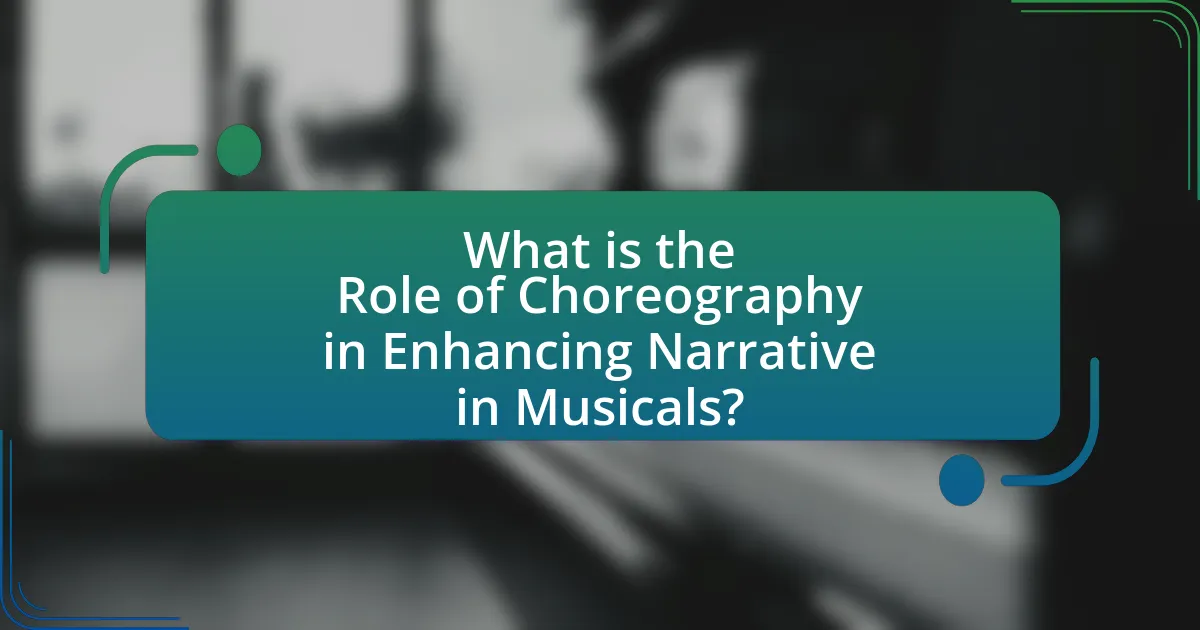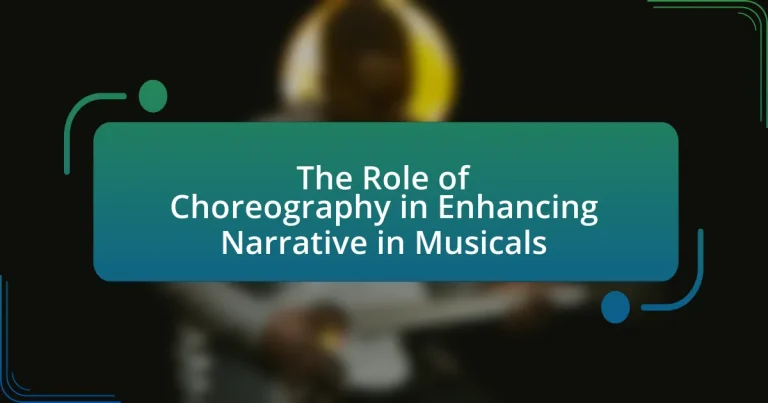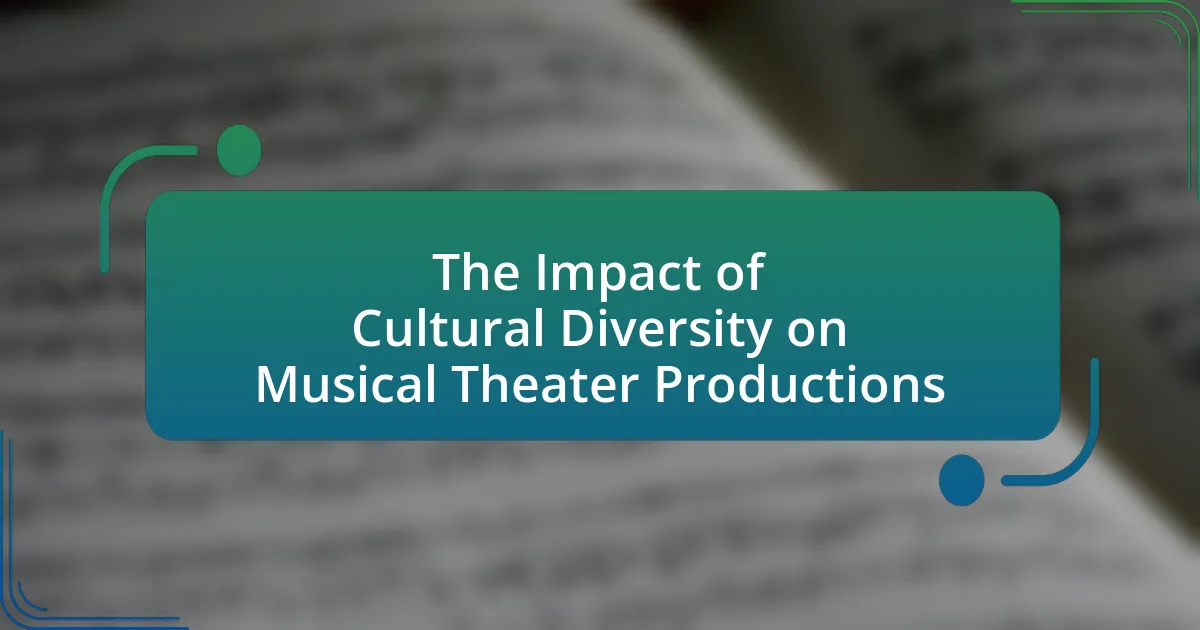Choreography is a vital component in enhancing narrative within musicals, serving to visually express emotions, character development, and plot progression. This article examines how choreography complements music and lyrics, contributing to storytelling by translating emotional and narrative elements into physical movement. Key elements such as movement quality, spatial dynamics, and thematic integration are discussed, along with historical developments that have shaped choreography’s role in musicals. The article also explores the challenges of integrating choreography with narrative and offers practical techniques for choreographers to effectively enhance storytelling through dance. Notable examples from famous musicals illustrate the impact of choreography on narrative delivery and character development.

What is the Role of Choreography in Enhancing Narrative in Musicals?
Choreography plays a crucial role in enhancing narrative in musicals by visually expressing emotions, character development, and plot progression. Through movement, choreography complements the lyrics and music, allowing audiences to grasp the underlying themes and emotional arcs more effectively. For instance, in “West Side Story,” the dance sequences not only showcase the characters’ relationships but also reflect the tension and conflict central to the story, thereby deepening the audience’s understanding of the narrative. This integration of dance with storytelling elements is essential, as it transforms abstract emotions into tangible experiences, making the narrative more engaging and impactful.
How does choreography contribute to storytelling in musicals?
Choreography significantly contributes to storytelling in musicals by visually expressing emotions and advancing the plot through movement. It serves as a narrative device that complements dialogue and music, allowing characters to convey their feelings and intentions without words. For instance, in “West Side Story,” the choreography not only illustrates the tension between rival gangs but also deepens the emotional connection between characters, enhancing the overall narrative. This integration of dance and storytelling is supported by research from the University of California, which highlights that movement can evoke emotional responses and clarify character motivations, thus reinforcing the storyline.
What are the key elements of choreography that enhance narrative?
The key elements of choreography that enhance narrative include movement quality, spatial dynamics, character expression, and thematic integration. Movement quality refers to the style and emotion conveyed through dance, which can reflect a character’s inner feelings or the story’s mood. Spatial dynamics involve the use of space and formations to illustrate relationships between characters and their environment, thereby advancing the plot. Character expression through choreography allows dancers to embody their roles, making the narrative more relatable and engaging. Thematic integration ensures that the choreography aligns with the overall themes of the musical, reinforcing the story’s message and emotional impact. These elements collectively contribute to a cohesive narrative experience in musicals.
How does choreography interact with music and lyrics to tell a story?
Choreography interacts with music and lyrics to tell a story by translating the emotional and narrative elements of the song into physical movement. This interaction enhances the storytelling by visually expressing the themes and emotions conveyed in the lyrics, allowing the audience to experience the narrative on multiple sensory levels. For example, in musicals like “West Side Story,” the choreography reflects the tension and passion of the characters, with dance sequences that embody the conflict and romance present in the music and lyrics. This synergy between movement and sound creates a cohesive narrative that deepens the audience’s understanding of the characters’ journeys and emotional states.
Why is choreography considered a vital component of musical theatre?
Choreography is considered a vital component of musical theatre because it enhances storytelling through movement and expression. In musical theatre, choreography serves to convey emotions, develop characters, and advance the plot, making the narrative more engaging for the audience. For instance, iconic musicals like “West Side Story” utilize dance to express the characters’ inner conflicts and relationships, effectively integrating movement with the storyline. This integration of choreography not only captivates the audience but also deepens their understanding of the narrative, demonstrating its essential role in the overall theatrical experience.
What historical developments have shaped the role of choreography in musicals?
The role of choreography in musicals has been shaped by several historical developments, including the influence of early theatrical forms, the integration of dance in vaudeville, and the evolution of Broadway. Early theatrical forms, such as opera and ballet, established a foundation for storytelling through movement, emphasizing the importance of choreography in conveying emotion and narrative. The rise of vaudeville in the late 19th and early 20th centuries introduced diverse dance styles and showcased choreography as a central element of entertainment, influencing musical theater’s structure and presentation.
The emergence of Broadway in the 1920s further transformed choreography’s role, with choreographers like George Balanchine and Jerome Robbins elevating dance to a narrative device that advanced plot and character development. The introduction of integrated musicals, such as “Oklahoma!” in 1943, demonstrated how choreography could enhance storytelling, making it an essential component of the musical form. These developments collectively established choreography as a vital element in the narrative framework of musicals, shaping its evolution and significance in the genre.
How do different styles of choreography influence narrative delivery?
Different styles of choreography significantly influence narrative delivery by shaping the emotional tone and pacing of a performance. For instance, contemporary choreography often employs fluid movements that can convey complex emotions and internal conflicts, enhancing character development and storytelling. In contrast, classical ballet typically utilizes structured, precise movements that can symbolize order and tradition, thereby reinforcing themes of discipline or societal norms within the narrative. Additionally, styles like jazz or hip-hop introduce energetic and dynamic movements that can reflect cultural contexts or social issues, thus deepening audience engagement with the story. Research indicates that choreography not only complements the music but also serves as a visual language that communicates character motivations and plot progression, making it a crucial element in the overall narrative structure of musicals.
What are the challenges faced in integrating choreography with narrative?
Integrating choreography with narrative presents challenges such as maintaining coherence between movement and storyline, ensuring that dance enhances rather than distracts from the plot, and aligning the emotional tone of choreography with character development. These challenges arise because choreography must not only be visually engaging but also serve the narrative’s progression and emotional depth. For instance, if a dance sequence does not reflect the characters’ motivations or the story’s context, it can create dissonance, leading to audience confusion. Additionally, the timing and pacing of choreography must align with dialogue and musical elements, which can complicate the overall production process.
How can choreographers overcome obstacles in storytelling through dance?
Choreographers can overcome obstacles in storytelling through dance by employing clear thematic movement vocabulary that aligns with the narrative. This approach allows for the expression of emotions and plot points through specific gestures and formations, making the story accessible to the audience. For instance, the use of contrasting styles can highlight character development or emotional shifts, as seen in productions like “West Side Story,” where the choreography reflects the tension between rival gangs. Additionally, integrating multimedia elements, such as projections or lighting, can enhance the storytelling by providing context and atmosphere, as demonstrated in “Hamilton,” where dynamic choreography complements the historical narrative. By focusing on these techniques, choreographers can effectively convey complex stories and engage audiences through the medium of dance.
What role does collaboration play in successful choreography and narrative integration?
Collaboration is essential for successful choreography and narrative integration, as it brings together diverse artistic perspectives and skills that enhance the storytelling process. In musicals, choreographers, directors, and performers work collectively to ensure that movement complements the narrative, creating a cohesive experience for the audience. For instance, the collaboration between choreographer Jerome Robbins and composer Leonard Bernstein in “West Side Story” exemplifies how integrated choreography can elevate the emotional depth of the narrative, making the dance sequences pivotal to character development and plot progression. This synergy not only enriches the visual storytelling but also fosters innovation, allowing for unique interpretations that resonate with viewers.
How does choreography enhance character development in musicals?
Choreography enhances character development in musicals by visually expressing emotions, motivations, and relationships through movement. This physical representation allows audiences to gain deeper insights into a character’s internal struggles and growth. For example, in “West Side Story,” the contrasting dance styles of the Jets and Sharks not only highlight their cultural differences but also reflect their individual identities and conflicts. Such choreography serves as a narrative device, reinforcing character arcs and emotional stakes, thereby making the story more engaging and relatable.
In what ways can choreography reflect a character’s emotions and motivations?
Choreography can reflect a character’s emotions and motivations through the use of movement, dynamics, and spatial relationships. Specific movements, such as sharp, aggressive gestures, can convey anger or frustration, while fluid, graceful motions may express joy or love. Additionally, the dynamics of the choreography, including tempo and energy levels, can indicate a character’s emotional state; for example, fast-paced movements can suggest excitement or urgency, while slow movements may reflect sadness or contemplation. Spatial relationships, such as proximity to other characters or the use of stage space, can also illustrate a character’s motivations, indicating connection or isolation. Research in dance and psychology shows that movement quality is closely tied to emotional expression, reinforcing the idea that choreography serves as a powerful tool for conveying complex character emotions and motivations in musicals.
How does the physicality of dance contribute to character arcs?
The physicality of dance significantly contributes to character arcs by visually expressing emotions and transformations that words alone cannot convey. Through movement, dancers embody their characters’ internal struggles, desires, and growth, allowing the audience to witness a tangible representation of their journey. For instance, a character’s transition from rigid, constrained movements to fluid, expansive gestures can symbolize personal liberation or emotional development. This alignment of physical expression with narrative progression enhances the storytelling, making character arcs more relatable and impactful. Studies in performance theory highlight that physicality in dance serves as a non-verbal language, effectively communicating complex emotional states and character evolution, thereby enriching the overall narrative in musicals.
What techniques can be used to effectively incorporate choreography into a musical’s narrative?
Techniques to effectively incorporate choreography into a musical’s narrative include using movement to express character emotions, advancing the plot through dance sequences, and integrating choreography with musical themes. Movement can convey feelings that dialogue may not fully express, enhancing character development. For instance, in “West Side Story,” the choreography reflects the tension and passion between rival gangs, directly influencing the narrative. Additionally, dance sequences can serve as pivotal plot points, such as in “Chicago,” where the choreography illustrates the characters’ ambitions and moral dilemmas. Finally, aligning choreography with musical motifs reinforces thematic elements, as seen in “The Lion King,” where movements echo the story’s connection to nature and the circle of life. These techniques demonstrate how choreography can be a vital storytelling tool in musicals.
How can choreographers align dance sequences with plot progression?
Choreographers can align dance sequences with plot progression by ensuring that the movements and formations reflect the emotional and narrative arcs of the story. This alignment is achieved through careful analysis of the script to identify key moments where dance can enhance character development or thematic elements. For instance, in the musical “West Side Story,” the choreography in the “Dance at the Gym” sequence not only showcases the characters’ relationships but also foreshadows the conflict that arises later in the plot. By integrating the choreography with the storyline, choreographers create a cohesive experience that deepens audience engagement and understanding of the narrative.
What are best practices for ensuring choreography complements the overall narrative?
Best practices for ensuring choreography complements the overall narrative include aligning movement with character development, emotional arcs, and thematic elements. Choreographers should analyze the script to identify key moments where dance can enhance storytelling, ensuring that each movement reflects the characters’ emotions and intentions. For instance, in “West Side Story,” the choreography not only showcases the characters’ backgrounds but also advances the plot, illustrating the tension between rival gangs through dynamic dance sequences. Additionally, integrating choreography with music and dialogue creates a cohesive experience, as seen in “Hamilton,” where the choreography is intricately tied to the rhythm and lyrics, reinforcing the narrative’s historical context.
What are some notable examples of choreography enhancing narrative in famous musicals?
Notable examples of choreography enhancing narrative in famous musicals include “West Side Story,” “Chicago,” and “The Lion King.” In “West Side Story,” Jerome Robbins’ choreography vividly illustrates the tension between rival gangs through dynamic dance sequences, particularly in the “Dance at the Gym” scene, which conveys character emotions and relationships without dialogue. In “Chicago,” Bob Fosse’s signature style uses choreography to reflect the characters’ inner thoughts and societal commentary, especially in the “Cell Block Tango,” where each dancer’s movement tells a personal story of crime and betrayal. “The Lion King” features Garth Fagan’s choreography that integrates African dance styles, enhancing the storytelling by embodying the characters’ connection to the circle of life, particularly in the “Circle of Life” opening number, which visually represents the themes of birth and community. These examples demonstrate how choreography serves as a powerful narrative tool in musicals, effectively conveying emotions and advancing the plot.
How did specific choreographic choices impact the storytelling in these productions?
Specific choreographic choices significantly enhanced storytelling in productions by visually conveying emotions and character development. For instance, in “West Side Story,” the use of sharp, aggressive movements during the dance sequences between the Jets and Sharks illustrated the tension and conflict between the rival gangs, effectively translating the narrative’s underlying themes of love and violence into physical expression. Additionally, in “Hamilton,” the choreography integrates historical context with contemporary dance styles, allowing the audience to connect with the characters’ struggles and aspirations in a relatable manner. This blend of movement and narrative not only deepens the audience’s understanding of the plot but also reinforces character motivations and relationships, making the storytelling more impactful.
What lessons can be learned from successful musicals that effectively integrate choreography and narrative?
Successful musicals that effectively integrate choreography and narrative demonstrate that choreography can enhance storytelling by conveying emotions and character development. For instance, in “West Side Story,” the choreography not only entertains but also reflects the tension and passion between rival gangs, illustrating how movement can express complex themes. Additionally, “Hamilton” uses choreography to advance the plot and deepen character relationships, showing that well-structured dance sequences can serve as a narrative device. These examples highlight that choreography should be purposefully designed to align with the narrative, ensuring that each movement contributes to the overall story arc and emotional impact.
What practical tips can be applied to enhance narrative through choreography in new musicals?
To enhance narrative through choreography in new musicals, choreographers should focus on character-driven movement, ensuring that dance reflects the emotional journey and motivations of the characters. This approach allows the choreography to serve as a visual storytelling tool, deepening audience engagement. For instance, in “Hamilton,” the choreography complements the narrative by illustrating the characters’ struggles and triumphs, effectively conveying their arcs through movement. Additionally, integrating choreography with the musical score can create a cohesive experience, as seen in “West Side Story,” where the dance sequences are intricately tied to the music, enhancing the overall narrative flow.



